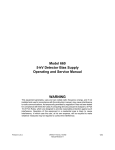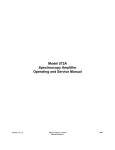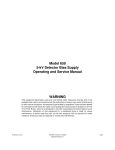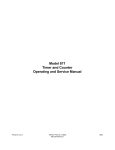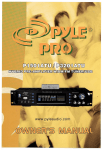Download Model 550A Single-Channel Analyzer Operating and Service Manual
Transcript
Model 550A
Single-Channel Analyzer
Operating and Service Manual
Printed in U.S.A.
ORTEC® Part No. 740260
Manual Revision B
1202
Advanced Measurement Technology, Inc.
a/k/a/ ORTEC®, a subsidiary of AMETEK®, Inc.
WARRANTY
ORTEC* warrants that the items will be delivered free from defects in material or workmanship. ORTEC makes
no other warranties, express or implied, and specifically NO WARRANTY OF MERCHANTABILITY OR
FITNESS FOR A PARTICULAR PURPOSE.
ORTEC’s exclusive liability is limited to repairing or replacing at ORTEC’s option, items found by ORTEC to
be defective in workmanship or materials within one year from the date of delivery. ORTEC’s liability on any
claim of any kind, including negligence, loss, or damages arising out of, connected with, or from the performance
or breach thereof, or from the manufacture, sale, delivery, resale, repair, or use of any item or services covered
by this agreement or purchase order, shall in no case exceed the price allocable to the item or service furnished
or any part thereof that gives rise to the claim. In the event ORTEC fails to manufacture or deliver items called
for in this agreement or purchase order, ORTEC’s exclusive liability and buyer’s exclusive remedy shall be release
of the buyer from the obligation to pay the purchase price. In no event shall ORTEC be liable for special or
consequential damages.
Quality Control
Before being approved for shipment, each ORTEC instrument must pass a stringent set of quality control tests
designed to expose any flaws in materials or workmanship. Permanent records of these tests are maintained for
use in warranty repair and as a source of statistical information for design improvements.
Repair Service
If it becomes necessary to return this instrument for repair, it is essential that Customer Services be contacted in
advance of its return so that a Return Authorization Number can be assigned to the unit. Also, ORTEC must be
informed, either in writing, by telephone [(865) 482-4411] or by facsimile transmission [(865) 483-2133], of the
nature of the fault of the instrument being returned and of the model, serial, and revision ("Rev" on rear panel)
numbers. Failure to do so may cause unnecessary delays in getting the unit repaired. The ORTEC standard
procedure requires that instruments returned for repair pass the same quality control tests that are used for
new-production instruments. Instruments that are returned should be packed so that they will withstand normal
transit handling and must be shipped PREPAID via Air Parcel Post or United Parcel Service to the designated
ORTEC repair center. The address label and the package should include the Return Authorization Number
assigned. Instruments being returned that are damaged in transit due to inadequate packing will be repaired at the
sender's expense, and it will be the sender's responsibility to make claim with the shipper. Instruments not in
warranty should follow the same procedure and ORTEC will provide a quotation.
Damage in Transit
Shipments should be examined immediately upon receipt for evidence of external or concealed damage. The carrier
making delivery should be notified immediately of any such damage, since the carrier is normally liable for damage
in shipment. Packing materials, waybills, and other such documentation should be preserved in order to establish
claims. After such notification to the carrier, please notify ORTEC of the circumstances so that assistance can be
provided in making damage claims and in providing replacement equipment, if necessary.
Copyright © 2002, Advanced Measurement Technology, Inc. All rights reserved.
*ORTEC® is a registered trademark of Advanced Measurement Technology, Inc. All other trademarks used
herein are the property of their respective owners.
iii
CONTENTS
WARRANTY . . . . . . . . . . . . . . . . . . . . . . . . . . . . . . . . . . . . . . . . . . . . . . . . . . . . . . . . . . . . . . . . . . . . . . . ii
SAFETY INSTRUCTIONS AND SYMBOLS . . . . . . . . . . . . . . . . . . . . . . . . . . . . . . . . . . . . . . . . . . . . . . . iv
SAFETY WARNINGS AND CLEANING INSTRUCTIONS . . . . . . . . . . . . . . . . . . . . . . . . . . . . . . . . . . . . . v
1. DESCRIPTION . . . . . . . . . . . . . . . . . . . . . . . . . . . . . . . . . . . . . . . . . . . . . . . . . . . . . . . . . . . . . . . . . . . 1
2. SPECIFICATIONS . . . . . . . . . . . . . . . . . . . . . . . . . . . . . . . . . . . . . . . . . . . . . . . . . . . . . . . . . . . . . . . .
2.1. PERFORMANCE . . . . . . . . . . . . . . . . . . . . . . . . . . . . . . . . . . . . . . . . . . . . . . . . . . . . . . . . . . .
2.2. INDICATORS . . . . . . . . . . . . . . . . . . . . . . . . . . . . . . . . . . . . . . . . . . . . . . . . . . . . . . . . . . . . . .
2.3. CONTROLS . . . . . . . . . . . . . . . . . . . . . . . . . . . . . . . . . . . . . . . . . . . . . . . . . . . . . . . . . . . . . . .
2.4. INPUTS . . . . . . . . . . . . . . . . . . . . . . . . . . . . . . . . . . . . . . . . . . . . . . . . . . . . . . . . . . . . . . . . . .
2.5. OUTPUTS . . . . . . . . . . . . . . . . . . . . . . . . . . . . . . . . . . . . . . . . . . . . . . . . . . . . . . . . . . . . . . . .
2.6. ELECTRICAL AND MECHANICAL . . . . . . . . . . . . . . . . . . . . . . . . . . . . . . . . . . . . . . . . . . . . . .
2.7. ORDERING INFORMATION . . . . . . . . . . . . . . . . . . . . . . . . . . . . . . . . . . . . . . . . . . . . . . . . . . .
2
2
2
2
2
3
3
3
3. INSTALLATION . . . . . . . . . . . . . . . . . . . . . . . . . . . . . . . . . . . . . . . . . . . . . . . . . . . . . . . . . . . . . . . . . .
3.1. CONNECTION TO POWER . . . . . . . . . . . . . . . . . . . . . . . . . . . . . . . . . . . . . . . . . . . . . . . . . . .
3.2. CONNECTION FROM LINEAR AMPLIFIERS . . . . . . . . . . . . . . . . . . . . . . . . . . . . . . . . . . . . . .
3.3. OUTPUT CONNECTIONS . . . . . . . . . . . . . . . . . . . . . . . . . . . . . . . . . . . . . . . . . . . . . . . . . . . .
3.4. LOWER LEVEL REFERENCE INPUT . . . . . . . . . . . . . . . . . . . . . . . . . . . . . . . . . . . . . . . . . . .
3
3
3
4
4
4. OPERATING INSTRUCTIONS . . . . . . . . . . . . . . . . . . . . . . . . . . . . . . . . . . . . . . . . . . . . . . . . . . . . . . . 4
5. MAINTENANCE AND CALIBRATION . . . . . . . . . . . . . . . . . . . . . . . . . . . . . . . . . . . . . . . . . . . . . . . . . .
5.1. GENERAL . . . . . . . . . . . . . . . . . . . . . . . . . . . . . . . . . . . . . . . . . . . . . . . . . . . . . . . . . . . . . . . .
5.2. FACTORY REPAIR . . . . . . . . . . . . . . . . . . . . . . . . . . . . . . . . . . . . . . . . . . . . . . . . . . . . . . . . .
5.3. TABULATED TEST POINT VOLTAGES . . . . . . . . . . . . . . . . . . . . . . . . . . . . . . . . . . . . . . . . . .
5
5
5
5
iv
SAFETY INSTRUCTIONS AND SYMBOLS
This manual contains up to three levels of safety instructions that must be observed in order to avoid
personal injury and/or damage to equipment or other property. These are:
DANGER
Indicates a hazard that could result in death or serious bodily harm if the safety instruction
is not observed.
WARNING
Indicates a hazard that could result in bodily harm if the safety instruction is not observed.
CAUTION
Indicates a hazard that could result in property damage if the safety instruction is not
observed.
Please read all safety instructions carefully and make sure you understand them fully before attempting to
use this product.
In addition, the following symbol may appear on the product:
ATTENTION–Refer to Manual
DANGER–High Voltage
Please read all safety instructions carefully and make sure you understand them fully before attempting to
use this product.
v
SAFETY WARNINGS AND CLEANING INSTRUCTIONS
DANGER
Opening the cover of this instrument is likely to expose dangerous voltages. Disconnect the
instrument from all voltage sources while it is being opened.
WARNING Using this instrument in a manner not specified by the manufacturer may impair the
protection provided by the instrument.
Cleaning Instructions
To clean the instrument exterior:
! Unplug the instrument from the ac power supply.
! Remove loose dust on the outside of the instrument with a lint-free cloth.
! Remove remaining dirt with a lint-free cloth dampened in a general-purpose detergent and water
solution. Do not use abrasive cleaners.
CAUTION To prevent moisture inside of the instrument during external cleaning, use only enough liquid
to dampen the cloth or applicator.
!
Allow the instrument to dry completely before reconnecting it to the power source.
vi
1
ORTEC MODEL 550A
SINGLE-CHANNEL ANALYZER
1. DESCRIPTION
The ORTEC Model 550A Single-Channel Analyzer
is ideally suited for selecting a range of output pulse
amplitudes from a spectroscopy amplifier for
subsequent counting on a ratemeter or a
counter/timer. It provides the excellent stability,
resolution, and dynamic range needed for
measurements with high-resolution-germanium and
silicon detectors. These same features provide
more than adequate performance with scintillation
counters, proportional counters, and ionization
chambers. The entire instrument is dc-coupled to
ensure that the discriminator levels are not affected
by changes in the counting rate, even at very high
counting rates.
The versatility of the Model 550A is enhanced by
four basic operating modes. In the INTEGRAL
mode, all input pulse amplitudes above the lower
level produce an SCA output logic pulse. This mode
is useful for counting all pulses above the noise
level, or above a well-defined lower amplitude limit.
The INTEGRAL mode can also be used for leading
edge timing, or pulse routing logic. In the NORMAL
mode, the upper and lower level discriminators are
independently variable over the full +20 mV to +10
V range. The SCA output is generated only for
pulse amplitudes that occur between the upper and
lower levels. This mode is useful when a wide range
of pulse heights must be selected for counting. In
the ASYMMETRIC WINDOW mode, the upper
level dial becomes a window width control with a 0
to +1 V range. The lower level dial controls the
lower limit of the window over a +20 mV to +10 V
range. Pulse amplitudes between the upper and
lower limits of the window produce an SCA output.
This mode is useful when a narrow range of pulse
heights must be selected. In the SYMMETRIC
WINDOW mode, the upper level dial still controls
the window width over the range of 0 to +1 V, but
the lower level dial sets the position of the center of
the window over a range of +20 mV to +10 V. The
SYMMETRIC WINDOW mode is useful when the
window has been centered on a peak in the
spectrum and it is desirable to widen (or narrow) the
window to accept more (or less) of the peak width.
Rear-panel connectors provide separate outputs for
the upper and lower level discriminators. These
logic outputs are generated at the instant the input
signal exceeds the corresponding discriminator
level. The SCA output logic pulse is generated
when the input signal falls through the lower level
threshold.
An external input for the lower level setting is switch
selectable to allow recording the entire pulse-height
spectrum utilizing a scanning technique. A narrow
window is selected, and an external voltage source
is employed to slowly scan the lower level through
the 0 to 10 V range. A ratemeter counts the SCA
output and draws the spectrum on a strip chart
recorder.
2
2. SPECIFICATIONS
2.1. PERFORMANCE
DYNAMIC RANGE 500:1.
PULSE-PAIR RESOLVING TIME 100 ns plus
output pulse width.
THRESHOLD TEMPERATURE SENSITIVITY
<0.01% of full scale per °C, from 0 to 50°C, using
a NIM Class A power supply (referenced to -12 V).
WINDOW WIDTH CONSTANCY #±0.1% variation
of full-scale window width over the linear range of
5 mv to 10 V.
DISCRIMINATOR NONLINEARITY #±0.25% of full
scale for both discriminators.
2.2. INDICATORS
SCA OUT LED Front-panel LED flashes whenever
an SCA output pulse is generated.
2.3. CONTROLS
WINDOW OR UPPER LEVEL Front-panel, 10-turn,
locking dial determines the window width (0 to 1 V)
in the WINDOW modes, or the upper level
threshold (0 to +10V) in the NORMAL and
INTEGRAL modes.
LOWER LEVEL Front-panel, 10-turn, locking dial
determines the threshold setting (+20 mV to +10 V)
for the lower level discriminator when the rear-panel
LL REF switch is in the INT position. The LOWER
LEVEL control is disabled when the EXT position is
selected on the rear-panel LL REF switch.
INT, ASYM WINDOW, SYM WINDOW, NORM
Front-panel, four-position rotary switch selects one
of four operating modes:
INT In the INTEGRAL mode, the lower level and
upper level are independently adjustable from +20
mV to +10 V. The SCA OUT is generated for all
pulse amplitudes exceeding the lower level
threshold.
NORM In the NORMAL mode, the lower level and
upper level are independently adjustable from +20
mV to +10 V. The SCA OUT is generated for pulse
amplitudes which exceed the lower level threshold,
but do not exceed the upper level threshold.
ASYM WINDOW In the ASYMMETRIC WINDOW
mode, the lower limit of the window is adjustable
from +20 mV to +10 V using the LOWER LEVEL
dial. The WINDOW dial adjusts the width of the
window from 0 to 1 V. The SCA OUT is generated
for pulse amplitudes between the upper and lower
limits of the window.
SYM WINDOW In the SYMMETRIC WINDOW
mode, the center of the window is adjustable from
+20 mV to +10 V using the LOWER LEVEL dial.
The WINDOW dial adjusts the width of the window
from 0 to 1 V. The SCA OUT is generated for pulse
amplitudes between the upper and lower limits of
the window.
INT/EXT LL. REF A rear-panel locking toggle
switch selects either the front-panel LOWER LEVEL
dial (INT position), or the rear-panel LL REF input
(EXT position) for controlling the lower level
threshold.
2.4. INPUTS
INPUT Front-panel BNC connector accepts unipolar
or bipolar linear signals for pulse amplitude
selection in the range of +20 mV to +10 V. The
minimum input pulse width is 100 ns. The
maximum amplitude of signal plus dc offset is ±12
V. Input impedance is approximately 1000
.
Front-panel test point wired to the INPUT connector
through a 470- resistor.
S
S
IN Rear-panel BNC connector identical to INPUT
connector.
LL REF Rear-panel BNC connector accepts a dc
voltage from an external source for controlling the
lower level threshold when the INT/EXT LL REF
switch is in the EXT position. The input range of -20
mV to -10 V corresponds to a lower level threshold
range of +20 mV to +10 V. The input is overload
protected to ±15 V.
3
2.5. OUTPUTS
SCA OUT Front- and rear-panel BNC connectors
provide a NIM-standard, positive logic pulse output:
nominally +5 V amplitude and 500-ns width. Output
impedance <15 . Front- and rear-panel outputs
have separate output drivers. The output pulse
occurs when the trailing edge of the linear input
pulse crosses the lower level threshold. See
description under CONTROLS for output logic
modes. Front- panel test point wired to the SCA
OUT connector through a 470- resistor.
S
S
LLOUT Rear-panel BNC connector provides a
NIM-standard, positive logic pulse output: nominally
+5 V amplitude and 500-ns width. Output
impedance <15 . The output pulse occurs when
the leading edge of the linear input pulse crosses
the lower level threshold (INT or NORMAL modes),
or the lower limit of the window (WINDOW modes).
S
the leading edge of the linear input pulse crosses
the upper level threshold (INT or NORMAL modes),
or the upper limit of the window (WINDOW modes).
2.6. ELECTRICAL AND MECHANICAL
POWER REQUIRED +12 V at 75 mA, -12 V at 35
mA.
WEIGHT
Net 0.9 kg (2.0 lb)
Shipping 2.3 kg (5.0 lb)
DIMENSIONS NIM-standard single-width module
3.43 X 22.13 cm (1.35 X 8.714 in.) front panel per
TID-20893 (Rev).
2.7. ORDERING INFORMATION
To order, specify:
UL OUT Rear-panel BNC connector provides a
NIM-standard, positive logic pulse output: nominally
+5 V amplitude and 500-ns width. Output
impedance <15 . The output pulse occurs when
Model 550A
Single-Channel Analyzer
S
3. INSTALLATION
The Model 550A contains no internal power supply,
but is used in conjunction with an ORTEC 4001
Series NIM Bin and 4002 Series Power Supply,
which is intended for rack mounting. If vacuum tube
equipment or any other source of heat is operated
in the same rack, there must be sufficient cooling
air circulated to prevent any localized heating of the
Model 550A. The temperature of equipment
mounted in racks can easily exceed the
recommended maximum unless precautions are
taken. The Model 550A should not be subjected to
temperatures in excess of 50°C (120° F).
When using the Model 550A outside an ORTEC
4001 Series NIM Bin and 4002 Series Power
Supply, be sure that the power extension cable in
use properly accounts for the power supply
grounding circuits that are provided according to the
recommended DOE standards outlined in TID20893 (Rev). Both high-quality and power-return
ground connections are provided to ensure proper
reference voltage feedback into the power supply,
and these must be preserved in remote cable
installations. Be careful also to avoid ground loops
when the module is operated outside the bin.
3.1. CONNECTION TO POWER
3.2. CONNECTION FROM LINEAR
AMPLIFIERS
Turn off the Bin and Power Supply when inserting
or removing modules.
Either of two inputs can be used for the analog
signals that are furnished from a linear amplifier.
Either input accepts positive unipolar or bipolar
4
pulses, but only the positive signal lobe will be
analyzed. When coaxial cables longer than about 4
ft are connected to the Model 550A input, cable
termination may be necessary to prevent reflections
from corrupting the signal to be analyzed. In this
situation, terminate the cable in its characteristic
impedance at the Model 550A input connector. The
input operating range is from +20 mV to +10 V, and
is compatible with NIM linear and biased amplifiers.
3.3. OUTPUT CONNECTIONS
The logic output pulses generated by the Model
550A are available from both front- and rear-panel
BNC connectors for convenience when installing
the Model 550A in a system. When the Model 550A
is used in the NORMAL or WINDOW modes, a
pulse from the SCA output means that the input
signal amplitude is large enough to trigger the
lower-level discriminator but not large enough to
trigger the upper-level or window discriminator.
When the Model 550A is in the INTEGRAL mode,
an SCA output pulse means that the input signal
amplitude is large enough to trigger the lower-level
discriminator.
Separate logic outputs are available on the rear
panel to indicate the time at which the leading edge
of the input signal triggered the level discriminators.
These outputs can be used to monitor the
discriminator levels during adjustment, counted in
external scalers, to provide subgroup routing in a
multichannel analyzer, or for other applications as
desired.
Each logic output is a NIM-standard slow-positive
pulse that is compatible with all ORTEC
instruments. The impedance of each output is
sufficiently low to drive as many as ten 1000
inputs in parallel.
S
3.4. LOWER LEVEL REFERENCE INPUT
If the toggle switch on the rear panel of the Model
550A is set to EXT, the front-panel Lower Level
control is disabled and the reference level for the
lower-level discriminator must be supplied through
the adjacent LL REF connector. An input of 0 to -10
V through this connector corresponds directly to a
range of 0 to +10 V for the lower-level discriminator
threshold. It a signal is connected to the LL REF
connector when the INT/EXT switch is in the INT
position, the signal through the connector is
ignored.
4. OPERATING INSTRUCTIONS
After the Model 550A has been installed in a
system according to the installation information in
Section 3, the operating mode can be selected and
the discriminator thresholds can be adjusted as
required for each application.
Figure 4.1 illustrates the timing relationships that
will be effective in the Model 550A for each of two
possible input pulse conditions. One is a pulse that
exceeds the lower-level threshold without
exceeding the upper level, and the other is a pulse
that exceeds both thresholds. If the front-panel
rotary switch selects the INTEGRAL mode, an SCA
output pulse is generated when the trailing edge of
each input pulse crosses the lower-level threshold.
If the NORMAL, SYMMETRIC WINDOW, or
Fig. 4.1. Timing Relationships for Input and Output
Pulses.
5
ASYMMETRIC WINDOW mode is selected, an
SCA output pulse is generated only by the pulse
which did not exceed the upper threshold or window
width. For any of the operating modes, the LL OUT
and UL OUT pulses are generated when the leading
edge of the input signal crosses the respective
threshold.
The lower-level threshold is supplied either by the
front-panel Lower Level control or by an external
source through the rear-panel LL REF connector,
depending on the position of the toggle switch on
the rear panel. In either case, the range of the
threshold is from 0 to +10 V, referred to the analog
input pulse.
The range of the upper-level threshold is
determined by the operating mode selected by the
front-panel rotary switch. In the INTEGRAL or
NORMAL mode, the threshold range is from 0 to
+10 V. In the ASYMMETRIC WINDOW mode, the
range is from 5 mV to 1 V above the lower-level
threshold. In the SYMMETRIC WINDOW mode, the
upper-level threshold (window width) can be
adjusted over the range of ±2.5 to ±500 mV, but it
is always symmetrical about the lower-level
threshold.
5. MAINTENANCE AND CALIBRATION
5.1. GENERAL
The basic performance of the Model 550A SingleChannel Analyzer can be inferred from its operating
responses.
5.2. FACTORY REPAIR
This instrument can be returned to ORTEC for
service and repair at a nominal cost. Our standard
procedure that ensures the same quality control
and checkout procedures used for a new instrument
are used for repairs. Always contact the Customer
Service Department at ORTEC (865-482-4411) to
obtain the required Return Authorization Number
before returning an instrument for repair. To
minimize delays, please include the Return
Authorization Number on the address label and on
the package itself.
5.3. TABULATED TEST POINT
VOLTAGES
The voltages given in Table 5.1 are intended to
indicate typical dc levels that can be measured on
the printed circuit board. In some cases the circuit
will perform satisfactorily even though some
voltages may differ slightly from the listed values
due to component tolerances. The tabulated
voltages are intended to serve as an aid in
troubleshooting and should not be interpreted as
absolute values.
All voltages in Table 5.1 were measured with no
input signal and with the front-panel mode switch
set for the INTEGRAL mode.
6
Table 5.1. Typical dc Voltages.
Bin/Module Connector Pin
Assignments For Standard
Nuclear Instrument Modules per
DOE/ER-0457T.
Pin
1
2
3
4
5
6
7
8
9
10
11
12
13
14
15
*16
*17
18
19
20
21
22
Function
+3 V
-3V
Spare bus
Reserved bus
Coaxial
Coaxial
Coaxial
200 V dc
Spare
+6 V
-6V
Reserved bus
Spare
Spare
Reserved
+12 V
- 12 V
Spare bus
Reserved bus
Spare
Spare
Reserved
Pin
23
24
25
26
27
*28
*29
30
31
32
*33
*34
35
36
37
38
39
40
*41
*42
G
Function
Reserved
Reserved
Reserved
Spare
Spare
+24 V
- 24 V
Spare bus
Spare
Spare
117 V ac (hot)
Power return ground
Reset (Scaler)
Gate
Reset (Auxiliary)
Coaxial
Coaxial
Coaxial
117 V ac (neutral)
High-quality ground
Ground guide pin
Pins marked (*) are installed and wired in
ORTEC’s 4001A and 4001C Modular System
Bins.













